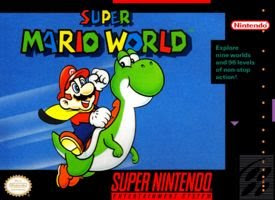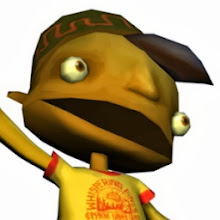 Often overlooked by almost every developer out there is how important control and feel are to the success of a title - this is important in literally any genre, but becomes crucial in some. No better illustration of this concept can be seen than in examining the plethora of mascot-platformers which inundated the marketplace during the 16-bit era. For a period it seemed that every developer - large and small - determined that it had to have its own mascot, and that this mascot had to star in his own platformer. After all, look at Nintendo and the Mario series, which Nintendo had seemingly ridden to the top of the industry. We still see this happening today, by the way, except now in the shooter genre.
Often overlooked by almost every developer out there is how important control and feel are to the success of a title - this is important in literally any genre, but becomes crucial in some. No better illustration of this concept can be seen than in examining the plethora of mascot-platformers which inundated the marketplace during the 16-bit era. For a period it seemed that every developer - large and small - determined that it had to have its own mascot, and that this mascot had to star in his own platformer. After all, look at Nintendo and the Mario series, which Nintendo had seemingly ridden to the top of the industry. We still see this happening today, by the way, except now in the shooter genre.The problem was all of these developers totally misjudged why Mario was so popular. It wasn't that people actually liked Mario as a character that much, outside of the fact that it was this Mario character who happened to star in these Mario games. It wasn't because Super Mario World looked that great, it doesn't really stand out much on the platform. And wasn't popular just because it happened to be packed in - we certainly don't call Genesis pack-in Altered Beast popular, do we. Super Mario World became so beloved because it was a ridiculously well made title, which would go pretty much unsurpassed in the genre for the duration of the 16-bit era (with the possible exception of its pseudo-sequel Yoshi's Island).
Competitors, it would seem, didn't catch onto this. They saw Mario as a character and figured, well hell, how is he even appealing to 90s youth in the first place, we can easily out-attitude a chubby plumber character. That Sonic and his manufactured edginess actually became a bona-fide hit on the Genesis pretty much confirmed this line of thought to these other developers, ensuring we'd spend the early 90s knee deep in Bubsy's, Aero's, Alfred Chicken's, and more. These titles were remarkably similar - large, detailed, and well-animated main characters (who exuded 'attitude'), sparse and uninspired level design, and sloppy play control and mechanics. Now, sometimes these mascot-driven platformers managed to work - a lot of people like Sonic, though their reasons make little sense to me, and Donkey Kong Country manages to be pretty good. But still, let's not go off and start patting these titles on the back, they still managed to be vastly inferior to Super Mario World where it matters - in control, level-design, and gameplay. That a couple of these dozens of titles managed to be ok is a cause for concern, not celebration.
Super Mario World succeeded because of a ridiculous level of polish which it manifested itself in every possible respect. Not a looker by the standards established by later SNES titles, Mario World still presented visuals which both did an excellent job of of demonstrating the power of the SNES hardware (through the use of effects like paralax scrolling, transparencies, and the occasional instance of mode-7) while building on the clean, utilitarian look established in Super Mario Bros. 3. Basically, it did an excellent job of presenting visuals that couldn't be replicated on the NES while avoiding the sort of flashiness and over-ambitiousness that hurt other titles of the era. The soundtrack worked similarly; so many contemporaries seemed to have real problems both with mixing their music (seemingly so excited to have 8 tracks of sound they neglected to take the time to make these tracks sound distinct) and in their selection of samples, with many tending towards the grainy or simply poorly designed for the SNES hardware (witness the dramatic improvement in sound quality between Final Fantasy IV and Final Fantasy VI). Super Mario World has one of the cleanest and clearest soundtracks the SNES ever saw.
Exceeding Nintendo's efforts on the presentation front, however, is the polish that went into level and control design. Control is, inherently, hard to describe using words - it is especially hard to describe what it is about Mario's controls that makes these games work so well. The key for me lies in contrasting it with Mario's number one competition of the time, Sonic the Hedgehog. Sonic's appeal, as I understand it, lies in running through the levels very, very quickly. To that end, the levels are designed somewhat like race tracks - the player is encouraged to complete the stages as quickly as possible and with stopping as little as possible (encouraged by both the presence of a timer, and Sonic controlling atrociously whenever he isn't going fast). This style falls apart for me for a few reasons, 1) you have to pretty much know the level to go through at full-speed consistently, 2) this tendency to design levels like race tracks leads to levels that overuse locales and elements to the point where it becomes hard to tell different areas apart, and 3) these two factors (samey level design and a need to memorize the levels) work directly against each other, meaning the player spends most of his time not moving fast, where again, Sonic controls absolutely atrociously. Basically, while its levels may contain many different paths to the end, there is a way Sonic is supposed to be played and a deviation from this method is going to lead to a bad time.
Super Mario World doesn't have a way it should be played, it instead has controls designed to stay as far out of the players way as possible. How the game is played is dictated by how the player wants to interact with the world presented. See a koopa ahead? You could hop on him and kick his shell away, hop on him and keep take his shell with you, spin jump on him and destroy him completely, hold down the jump button as you hop on him to use him to boost your jump, or just avoid him entirely. If you have Yoshi or another shell with you, a whole slew of other options open up to you. Enemies are rarely presented solely as obstacles, but more often as tools - as new ways for the player to interact with the environment around them. The levels are designed so as to encourage players to explore, not just for items, but for secret exits which may open up entirely new levels (or perhaps just to find something cool to play with). These secrets can be used to reach the ending while bypassing nearly every level. What's more, Mario can outright out-Sonic Sonic. Granted, the screen doesn't move nearly as fast, but running full-speed through Super Mario World often reveals just how well designed the levels are, with many levels such that a skilled player needn't ever slow down or be stopped by some obstacles. Some levels that prove taxing when taken at a slow pace are revealed to be simple by simply throwing caution to the wind. Contrast this to Sonic, where obstacles seem to exist with the purpose of changing up the pace (lest the player go too quickly). As with pretty much every other Mario title, the name of the game is simply 'play'.
So Super Mario World creams the shockingly weak competition in the 16-bit platformers, but how does it do amongst the Mario pantheon? For my money, it's tops of the side-scrollers. Mario's 1 & 2 are, of course, right out of the competition (no offense), leaving competition to be Yoshi's Island, New Super Mario Bros., and Mario 3. Yoshi's Island is excellent, but the way it handles secrets (being tied to items that need to be collected) sort of bogs it down - rewards are no longer things like shorter routes to the end of a world, but simply things that need to be collected for the sake of being collected. New Super Mario Bros. is also excellent, but lacks the sense of scale and the variety of skills on display here. And Mario 3, well, just doesn't strike the right feel to me - the levels are too short, the difficulty too inconsistent. Super Mario World strikes the perfect balance of these, and nearly lives up to the peaks reached by Mario 64 and Galaxy.
Special note: Super Mario World occupies numbers 26 (SNES), 156 (GBA), and 414 (Virtual Console) in my collection.
Super Mario World
Publisher: Nintendo
Developer: Nintendo EAD
Released: August 1991
Obtained: Christmas 1993 (Gift)
9.5/10
Publisher: Nintendo
Developer: Nintendo EAD
Released: August 1991
Obtained: Christmas 1993 (Gift)
9.5/10














